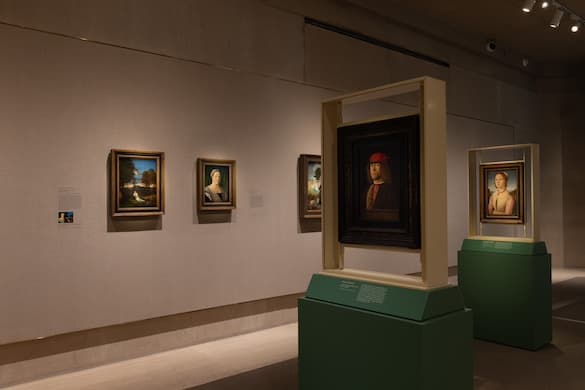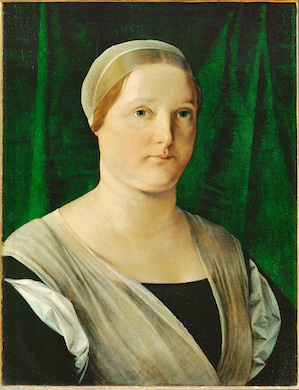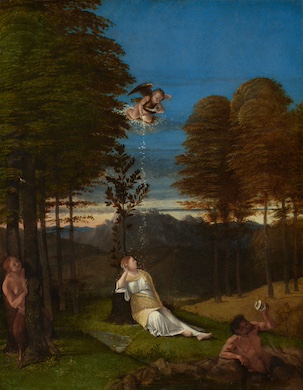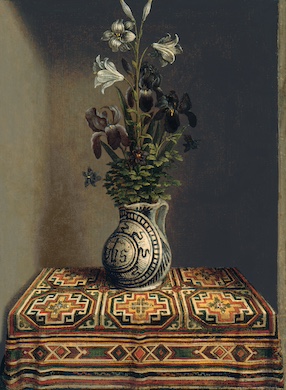At the Met, Watch for the Wild Man Among ‘Hidden Faces: Covered Portraits of the Renaissance’
The curator of the Met’s Robert Lehman Collection, Alison Manges Nogueira, has organized an exhibition devoted exclusively to portraiture whose subject was, in one way or another, made inaccessible.

Let’s forget Titian, Hans Holbein, Albrecht Durer, and other mainstays in the history of Western painting who are included in an exhibition at the Metropolitan Museum of Art, “Hidden Faces: Covered Portraits of the Renaissance.” Instead, can we talk about the wild man of medieval Europe?
The wild man shows up in three pieces at the Met, albeit only once in a prominent role: That would be a portrait cover attributed to the workshop of Jakob Elsner, a German artist who predates Durer by a good decade. Durer, too, was familiar with our “wild” man: the great printmaker and painter pictured him whispering into the ear of a bride in an exquisite engraving, “Coat of Arms with Skull” (1503). Finally, the wild man is visible amongst a field of surface distress on the reverse side of a portrait by Wolfgang Beurer, “Johann von Rückingen” (1487).
The wild man, the Met tells us, “is a legendary woodland figure commonly used as a heraldic bearer and symbol of fertility.” Its roots go back to antiquity — to fauns, satyrs, and the like — as well as the tale of Nebuchadnezzar, the Babylonian King who not only met with God’s disfavor but was rejected by the community of men, moved out to the woods, and subsequently grew a wealth of body hair. Fun fact: A great British humorist, P.G. Wodehouse, likely owes his surname to our hirsute outsider.

The wild man seems an appropriate mascot for “Hidden Faces,” as it’s an exhibition that concerns itself with subterfuge and transformation. The curator of the Met’s Robert Lehman Collection, Alison Manges Nogueira, has organized the first exhibition devoted exclusively to portraiture whose subject was, in one way or another, made inaccessible. These objects were, Ms. Nogueira writes, “often stored away and unveiled for special viewings,” and “were designed to restrict access to the sitters’ images.” Our erstwhile curator has put together a quirky show.
It’s a show that is also a disappointment, kind of, given not only how artworks have been dismantled through the centuries but the prerequisites of “please don’t touch the art” stewardship. Take one of the centerpieces of “Hidden Faces,” an oil-on-wood picture, “Portrait of a Woman (La Monaca)” (circa 1510), attributed to Ridolfo Ghirlandaio, grandson of Domenico and nephew of Davide. Once considered the portrait of a nun, Ghirlandaio’s sub-“Mona Lisa” has too low of a neckline to qualify as such. Conjecture now has it that she was a member of the patrician class.
At one point in time, “La Monaca” was placed within a wood sleeve over which could be slid another painting-on–panel attributed to Ridolfo, one that features a mask, some attendant “grotesqueries,” and an inscription in Latin that reads, “To each his own mask.” The theatrical allusions are clear; the funerary symbolism less so, though the accompanying literature elaborates on its meanings. Ridolfo underscored the correspondences in the two pictures through the similarities between the sitter’s aquiline nose and that of the mask, as well as the general shape of the heads.

Not a few steps away, you’ll find what is likely the exhibition’s finest picture, “Portrait of a Woman” (circa 1505), by Lorenzo Lotto. The competition for this designation is, admittedly, stiff, but the sui generis nature of the Lotto panel counts for something: This woman doesn’t hew to the standards of 16th-century portraiture. She’s notably unadorned — no jewelry, and her raiment is modest, even a bit prole. (Some scholars conjecture that she might have been a wet nurse.) That, and our lady is stolid, solid, and not elegant in the least.
The wall label, extending the curator’s diplomacy, extols Lotto’s “unsparing naturalism” in his depiction of this serious, dignified, and somewhat reticent personage. “Portrait of a Woman” has been paired with “Portrait Cover With an Allegory” (circa 1905), wherein Lotto has created a pastoral setting in which a woman is being showered with flower petals by a passing cherub. The pairing of the two paintings isn’t altogether certain, but there’s no denying the close resemblance between the women at the center of each.
The Met has included helpful video reconstructions of how several of the pieces may have originally operated, and the exhibition includes a vitrine or two of Roman coins whose double-sided imagery inspired Renaissance artists to attempt the recto/verso formatting. The most stunning of the versos on display is by a Netherlandish artist, Hans Memling: “Flowers in a Vase” (circa 1485), the flipside of “Portrait of a Man,” is a still-life of unfailing precision and extraordinary quietude.

Also worth noting are two carved wood boxes by the Meister der Dosenköpke in which Martin Luther’s protector, Frederich the Wise, is paired with his mistress Anna. Not far along is a suite of portable portrait miniatures modeled in wax, pieces whose tactility is too fleshlike for comfort.
“Hidden Faces” ends with an elaborate watch designed by Lambertus Vrythoff and decorated with paintings of mythological scenes. It’s a fitting finale for a show in which meticulous craft is the standard by which the rest of us, wild men included, can take pleasure.

